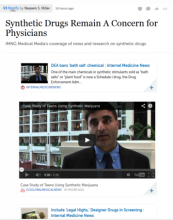In 2011, nearly 23,000 of 2.5 million drug-related emergency department visits were linked to a group of synthetic drugs called "bath salts," according to a report by the Substance Abuse and Mental Health Services Administration. The agency said this is the first national study to track such data.
The numbers are "worrisome, because these are relatively new drugs that we haven’t seen until the last few years," Dr. Elinore F. McCance-Katz, SAMHSA’s chief medical officer, said in an interview.
"These are drugs that are mainly abused by young people, and because of that, as physicians, we need to be attuned to the potential for misuse of these substance by younger people," Dr. McCance-Katz said. "And physicians need to be aware that we don’t have treatments that are specific to toxicities related to these drugs, so it’s going to be symptomatic treatment. And for individuals who do develop abuse or addiction to these drugs, there’s not a treatment that’s shown to be effective, so prevention is going to be important.
"Provide information to these young folks, and help keep them from starting the use of these drugs," she said.
The drugs’ adverse effects include heart and blood vessel problems, depression, suicidal thoughts, psychosis, and death.
The toxicities are similar to those of other stimulants seen in the ED, Dr. McCance-Katz said. "Treat the patients symptomatically. If they have severe hypertension, give medication to reduce blood pressure. If the person presents with severe agitation and anxiety, we might give them benzodiazepines. If that’s not helpful, and/or if they also have psychosis, we might give them an antipsychotic.
"But we need to be careful about the antipsychotic selection, because antipsychotics themselves can reduce the seizure threshold, as can happen with amphetamine abuse, so we don’t want to risk seizure. But in a patient who is severely agitated and psychotic, that may be the emergency treatment that is necessary."
Dr. McCance-Katz added that it’s important for psychiatrists to know that there are also adverse mental health symptoms, as seen with other amphetamines.
"Someone might present with toxicity from using this type of a drug with agitation, psychosis, a rapid heartbeat, possibly even chest pain, and severe anxiety, and that person would need a good bit of medical and psychiatric care," she said.
The report, based on the 2011 Drug Abuse Warning Network, or DAWN report, also showed that two-thirds (67%) of bath salt–related ED visits involved the use of another drug: 15% involved combined use of marijuana or synthetic forms of marijuana, and 52% involved the use of other drugs. Only 33% of the cases involved exposure to bath salts only.
Dr. McCance-Katz said the combined use means that these synthetic drugs could be even more dangerous to the users.
Synthetic drugs, including bath salts, were first detected in the United States in 2008 by the Drug Enforcement Administration (DEA).
Bath salts began to gain national attention in 2011, when poison centers reported a sudden jump to more than 6,000 cases of exposure to the drug, up from a mere 300 in 2010.
Since then, however, there has been a 10-fold drop in the number of calls to poison centers, in part because of increased local awareness, education, and federal actions.
In April of this year, the DEA put one of the main chemicals in bath salts in the Schedule I category, the most restrictive category created by the Controlled Substance Act. Several large national drug busts also have taken place in connection with the substance.
Bath salts come in the form of white or brown powder and contain one or more chemicals related to cathinone, an amphetamine-like stimulant. They are sold in packages that are labeled as household products, such as bath salts, or jewelry cleaner, and labeled as "legal high" or "not for human consumption." They can be taken by mouth, inhaled, or injected.
Dr. McCance-Katz stressed that patient education and prevention are key.
On Twitter @NaseemSMiller

